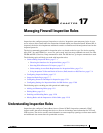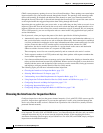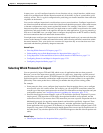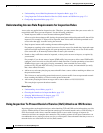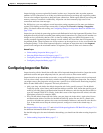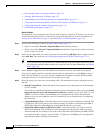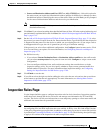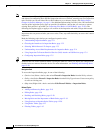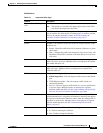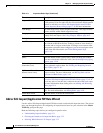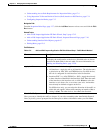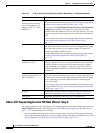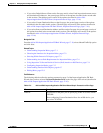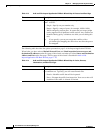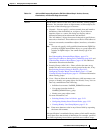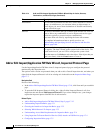
17-9
User Guide for Cisco Security Manager 4.4
OL-28826-01
Chapter 17 Managing Firewall Inspection Rules
Inspection Rules Page
Field Reference
Table 17-1 Inspection Rules Page
Element Description
Expand all rows/Collapse all
rows
Use these buttons to expand or collapse all sections in the rules table.
Note The buttons are located in the upper-right corner of the Filter
area above the inspection rules table.
Conflict Indicator icons Identifies conflicts and provides a quick visual representation of the
type of conflict. For more details, including types of conflicts and the
actions you can take from this column, see Understanding the
Automatic Conflict Detection User Interface, page 16-27.
No. The ordered rule number.
Permit Whether a rule identifies traffic that should be inspected based on the
conditions set:
• Permit—Identifies traffic that will be inspected. Shown as a green
check mark.
• Deny—Exempts the traffic from inspection. Your access rules will
determine if the traffic is allowed or blocked. Shown as a red circle
with slash.
Sources The sources of traffic for this rule; can be networks, security groups
(ASA 9.0+ only), and users. Multiple entries are displayed on separate
lines within the table cell.
Destinations The destinations for this rule; can be networks and security groups
(ASA 9.0+ only). Multiple entries are displayed on separate lines
within the table cell.
Traffic Match The type of matching used in the rule:
• default-inspection—The rule inspects traffic based on the default
port.
• TCP,UDP/port number—The rule inspects traffic based on a
custom port number.
• Service—The rule inspects traffic based on a service specification
or service object. Multiple entries are displayed as separate
subfields within the table cell. See Understanding and Specifying
Services and Service and Port List Objects, page 6-86.
Interface The interfaces or interface roles to which the rule is assigned. Global
indicates that the rule is assigned to all interfaces. Interface role objects
are replaced with the actual interface names when the configuration is
generated for each device. Multiple entries are displayed as separate
subfields within the table cell. See Understanding Interface Role
Objects, page 6-67.
Dir. The direction of the traffic to which this rule applies:
• In—Packets entering the interface.
• Out—Packets exiting the interface.



